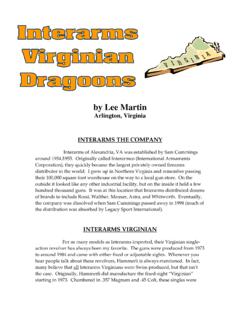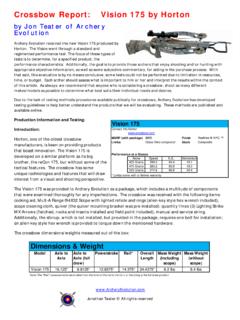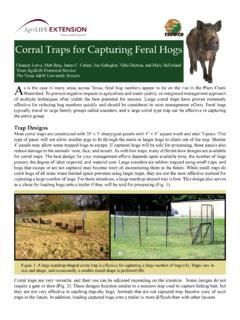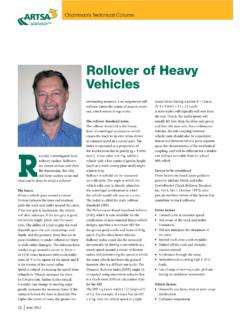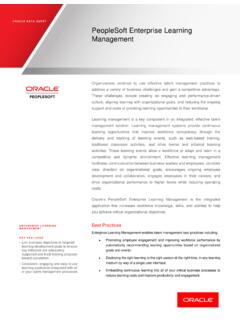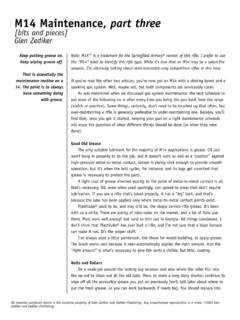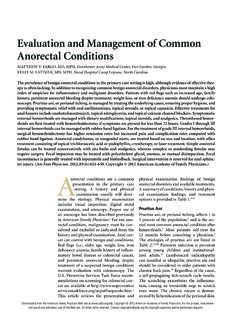Transcription of By Lee Martin - Single-Actions.com
1 By Lee MartinArlington, Virginia , this article has nothing to do with single-action revolvers. Actually, it s a rifle project that we undertook back in 1993 and I was extremely pleased with how it turned out. If nothing else, it somewhat dispells the myth of hyper-velocity rounds and precision shooting. My dad s gunsmithing hobby started with custom rifles in the 1970s and eventually led to the building of his own bench-rest actions. I should clarify, that by build , I mean he machines them from scratch to include both the receiver and bolt assembly. Essentially, everything is an in-shop proposition with the exception of the trigger mechanism. In the latter part of the 1980s, he began to devote a lot of time to benchrest rifles which included 6mm BRs.
2 25 Darts, .219 & 6mm Donaldson Wasps, other words, logical cartridges. Then I started reading Ackley s book on wildcat conversions and noticed a long-forgotten round called the 6mm Atlas. By design, it was merely a .264 Winchester Mag necked down to handle a mm bullet; no other changes with respect to body taper, case length, or shoulder position/angle were made. Obviously, the round was grossly overbore and pushed the limits of 6mm functionality. It would be incredible though for long-distance varmit hunting and if nothing else makes for fun when chronograph testing. We began work on what would become the .240 Incinerator in March of 1993 I liked the 6mm Atlas, but thought that an improved version would be more efficient.
3 With less than total body taper and a 35 degree shoulder, our wildcat would hold more powder than the .244 Holland and Holland and simplify case formation. Personally, I m fond of the old H&H because it was a radical departure from sensible commercial chamberings. Granted, it came out in a time (ie, 1950s) when wildcatting was immensely popular. Certainly, the Roy Weatherby s of the world expanded rifle performance with huge powder capacities and extreme velocity in and around this time. From the start though, our goal was simply to push 6mm slugs well in excess of 4,000 fps and still be accurate enough to nail ground hogs 400 yards off. The precision shooting piece of it was never a concern, even though other fast cartridges such as the.
4 220 Swift are capable of grouping well. This also was not to be considered a high-volume rifle in that barrel errosion would be a factor at these performance levels. To summarize, all I wanted was a decent shooting varmit gun that gave better trajectory out to 500 yards. In the end, I achieved this and a whole lot more. We built the chambering reamers first and followed suit with a set of reloading dies. Next came the action, which was in fact a lot of effort. I believe that this was the 9th or 10th receiver that my dad machined and in spite of his experience, it s still a tedious and time-consuming process. Most of his work has been with ported actions of the single-shot variety, though some were designed as shell-holder configurations.
5 In 1991, he actually built a massive single-shot bolt gun for the .50 BMG that functioned well. So successful was the design, that we merely shrunk it to a size better tailored to the .240 Incinerator. The advantage of using our own action was two-fold: 1) With a high-pressure cartridge like the Incinerator, the receiver was engineered for added strength. This was accomplished by not only a greater outside diameter but larger bolt locking lugs, and 2) Overall tolerances were tighter than a commercial receiver. Lastly, extraction is rarely an issue with a shell-holder action due to the bolt face s rim bearing surface (the receiver was machined from 4140 steel and heat treated to a tensile strength of 200,000 psi). We eventually ordered the barrel through Douglas and did not elect to go the match grade route.
6 It seemed somewhat pointless to invest a lot in a barrel that may only last 500 1,000 rounds and their standard grade has always proven accurate. Futhermore, we elected to use a 1 in 12 twist for lighter 6mm bullets and cut it to a final length of . I was also insistent on a good trigger and ended-up with a Shilen that was set to slightly over 2 ounces; light indeed, but very similar to what I m used to in heavy varmit guns. All of this was finally pillar bedded to a McMillan benchrest stock that was finished in black acrylic enamel. We did accent the gun with a home-built aluminum butt plate and trigger guard which were polished to a high-gloss finish. Scope selection took some thought due to my hesitance to pour hundreds into a Leupold or used Unertil.
7 Since the rifle was only expected to be a fair shooter, we settled on a variable 4 16x Weaver with the gun being finalized in June of 1993. Case forming involves nothing more than running a .264 Winchester Magnum into an Incinerator sizing die. Fire forming is required to expand the case body and shoulder, but the neck length is unaltered at . It is very important though to maintain a neck thickness of no greater than . Overly tight necks and extremely high pressure can turn your action into something that is bomb-like. Once initial case preparation was complete, our fire-form loads were made using 59 grains of IMR 4350 under a 70 grain Nosler ballistic tip. Really, I didn t expect much from this combination because that powder is a little fast for something so over-bore.
8 Regardless, these chronographed at 3,750 fps with no sign of excessive pressure. Now even though we viewed 4350 as not being ideal for the Incinerator, we worked up to 65 grains and achieved a speed of 4,120 fps. This wasn t bad considering that slower powders such as H870 and IMR 7828 were still untested. What was surprising were the 100 yard groups returned by the round. My first 3-shot attempt measured using a 70 Nosler at 3,900 fps. Subsequent 3-shot tests continued to average a half-inch at near 4,000 fps speeds in spite of significant barrel heating. It was largely because of the heat issue that we didn t initially attempt 5-shot groups. When we finally did, the results were outstanding with two measuring in the range while one closed out at (a picture of latter is posted below).
9 How fast is the Incinerator with slower propellants and which should be optimal? I personally believe that H870, WC872, WC860, AA 8700 and IMR 7828 are excellent choices. Unfortunately, Hodgen is no longer offering H870 and 872/860 are military surplus powders that are difficult to obtain (a good source for surplus powder is ). Of those noted, I recommend IMR 7828 because it is available and is slow enough to work in the Incinerator. Appendix #1 will give some idea of maximum speed out of a tube and as you can see, a 70 grain BT can reach 4,400 fps. Though my gun isn t intended for heavy bullets, a 95 grain Nosler can eclipse 3,900 while the 100 grain Partition peaks around 3,800 fps. Functionally, extraction isn t a problem and pressure has been kept in check (note: our action is designed to handle pressures far in excess of 60,000 CUP.)
10 I cannot speak for the safety of these loads in any other firearm). Though these velocities are impressive, a 70 ballistic tip at 4,400 fps is a little much for a couple of reasons. One, accuracy is best when held to the 3,900 to 4,100 fps range. Secondly, barrel errosion certainly is accelerated when driving bullets near Mach IV and half. Regardless, I do recommend that the bore be thoroughly cleaned after every 10-12 rounds (JB solvent works well). Though this step won t eliminate such wear, it should help prolong barrel life and reduce copper fouling. The summer of 93 closed out and I went back for my final year of college at the University of Pittsburgh. Within a couple months of my return, I picked up a copy of Guns & Ammo to find that Ross Seyfried had done an article on his new 6mm Mach IV.


